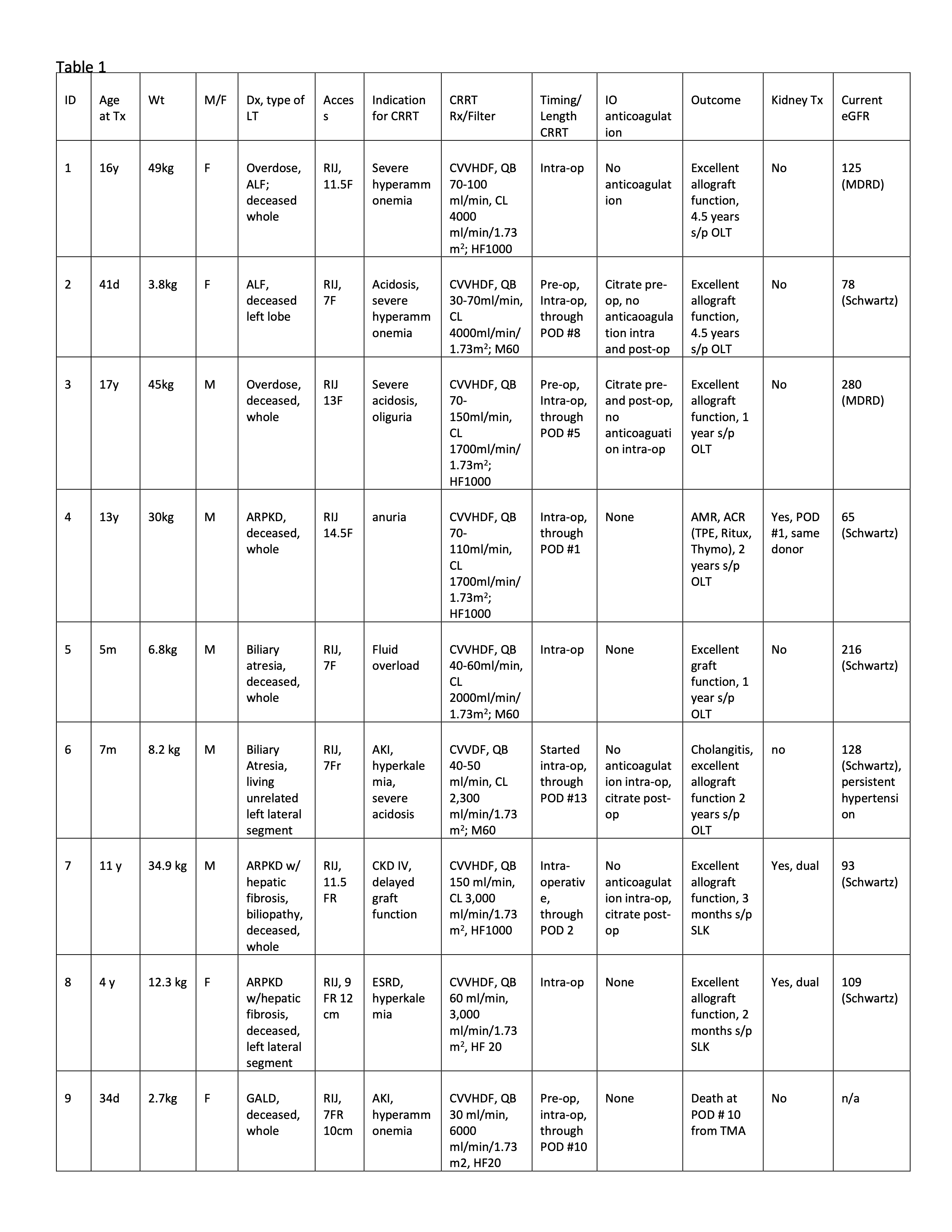On the Circuit: Intra-Operative CRRT in Pediatric Liver Transplant Recipients with Acute Kidney Injury
1Pediatric Nephrology, University of Colorado, Aurora, CO, 2Transplant Pharmacy, University of North Carolina, Raleigh, NC, 3Transplant Surgery, University of Colorado, Aurora, CO
Meeting: 2022 American Transplant Congress
Abstract number: 1450
Keywords: Donation, Liver, Pediatric, Renal dysfunction
Topic: Clinical Science » Liver » 61 - Liver: Pediatrics
Session Information
Session Time: 7:00pm-8:00pm
 Presentation Time: 7:00pm-8:00pm
Presentation Time: 7:00pm-8:00pm
Location: Hynes Halls C & D
*Purpose: Acute renal failure is common in pediatric patients undergoing liver transplantation (LT), with an incidence of 17-55%. Fluid, metabolic and acid-base aberrancies are often pronounced pre-operatively and further worsened by events during LT surgery, making intra-operative continuous renal replacement therapy (IO-CRRT) an attractive option for critically ill LT recipients. Often used in adult LT recipients, literature supporting IO-CRRT use in pediatric LT is lacking. We present a single center case series of pediatric patients with successful IO-CRRT use during LT.
*Methods: All pediatric LT recipients at our institution who underwent IO-CRRT between January 2017- November 2021 were included. Patient demographics and clinical data including graft outcomes, intraoperative findings, indications for and logistics of IO-CRRT were collected from the electronic health record.
*Results: 9 pediatric patients received IO-CRRT during LT (Table 1). Ages at time of LT ranged from 34 days to 17 years; with 4 infants under 10 kg. 3 patients received simultaneous or sequential liver/kidney transplants. Dialysis and hemodynamic monitoring access was secured prior to transplant, CRRT circuit blood flow (QB) was reduced by about 25-50% during cross-clamping of the inferior vena cava, and QB was readjusted after organ reperfusion. Metabolic, acid-base and fluid aberrancies, were maintained within acceptable limits intra-operatively for all. Multiple dialysate and replacement fluids compositions were readily available to best react to clinical changes, particularly following organ reperfusion. 6 patients continued CRRT post-operatively, with longest period extending through post-operative day 13. All living patients (8/9) have good kidney function (CKD Stages 1-2) and excellent liver allograft function, with follow-up of 4 months to 4.5 years.
*Conclusions: Intra-operative CRRT during pediatric LT, although challenging, is a promising tool to support medically complex patients during their intra-operative course. This intervention allows for close monitoring and control to decrease the risk for electrolyte, fluid and acid-base aberrancies that might otherwise result in poor patient and allograft outcomes. We demonstrate that IO-CRRT can be safely performed in pediatric LT recipients, including very young, small infants, children and adolescents.
To cite this abstract in AMA style:
Blanchette E, Chandran M, Yoeli D, Adams M, Bock M. On the Circuit: Intra-Operative CRRT in Pediatric Liver Transplant Recipients with Acute Kidney Injury [abstract]. Am J Transplant. 2022; 22 (suppl 3). https://atcmeetingabstracts.com/abstract/on-the-circuit-intra-operative-crrt-in-pediatric-liver-transplant-recipients-with-acute-kidney-injury/. Accessed December 29, 2025.« Back to 2022 American Transplant Congress

